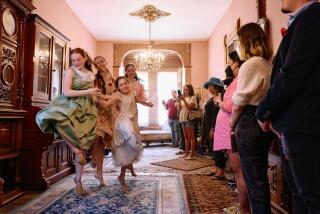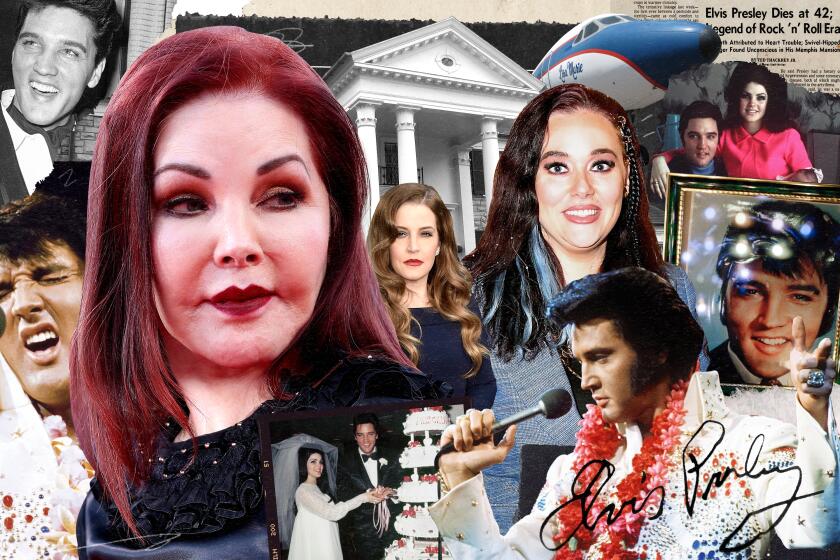BALLET REVIEW : Nureyev’s Glitzy ‘Cinderella’
- Share via
See the pretty, long-legged heroine dance with a coat rack, just like Fred Astaire in “Royal Wedding.”
See her don a derby, grab a cane and knock off a cute-cute-cute tippy-toe imitation of Charlie Chaplin as the little tramp.
See none other than Rudolf Nureyev, the world’s leading 50-year-old ballerino, chomp a cigar, hunch over and grind out a tenuous, irrelevant impression of Groucho Marx.
See a cast of thousands--well, nearly thousands--hoof and traipse and preen amid 30-foot statues of King Kong and Betty Grable.
See the wind-swept hero and heroine, happily reunited at last, fade prettily into the moonlight while flailing that billowing scarf from “Singin’ in the Rain.”
See fuzzy evocations of the Keystone Kops, Broncho Billy, Fritz Lang’s “Metropolis” and a very drab fashion show from the quasi-chic Parisian house of Hanae Mori.
See it all sprawling listlessly and witlessly on the cramped but lavish stage of the Orange County Performing Arts Center.
This is Prokofiev’s beleaguered “Cinderella” as staged and choreographed by the ever-indulgent Nureyev for the Paris Opera Ballet-- his Paris Opera Ballet.
The scene is Hollywood, sort-of in the 1930s. The titular waif is a poor, would-be starlet. The prince is a matinee idol. The stepmother is a drag queen. The fairy godmother is a kindly movie mogul.
Whoopee. That’s entertainment.
This “Cinderella,” savaged by most of the New York press last year, isn’t exactly the sort of production that warms a purist’s cockles. One wouldn’t mind that, much, if the iconoclasm were buoyed by brilliance and bona fide inspiration. Nureyev, unfortunately, has merely trivialized, padded and/or distorted the original impulses in a wild quest to be trendy.
He has ignored the dark, brooding romanticism of the score. The serious music is forced to accompany silly charades. The agitated music supports languid dance routines. The lyrical music reinforces nervous busywork.
The basic incompatibility of sight and sound seemed doubly ironic here, for Prokofiev was remarkably well served in the resonant Segerstrom Hall pit. John Lanchbery, the Toscanini of the ballet, conducted with equal parts finesse and fervor, and elicited marvelous playing from a reasonable facsimile of the Pacific Symphony.
If the quality of the choreography could have remotely approached the quality of the music-making, this certainly would have been a “Cinderella” to cherish. Nureyev is too busy concocting gimmicks, however, to define, much less develop, balletic ideas.
He reduces Cinderella to a dull sitcom protagonist. He makes the prince a leaping afterthought. He allows both to get lost in the crowd and to be be dwarfed by the decors.
Under the circumstances, the viewer is best advised to sit back, relax, try to stay awake, search for the in-jokes and savor what can be seen of the excellent Paris dancers.
Sylvie Guillem may not be a particularly vulnerable Cinderella, but she is irresistibly grand, suave and chic, even in gray chiffon rags. She can show off dazzling, nonchalant leg extensions. She knows how to make the acrobatic look artistic, and does sweet things in an amorous pas de trois with her cavalier and a revolving stool borrowed from Judy Garland. Los Angeles deserves to see her, soon, in a real ballet.
Charles Jude as the airborne actor who loves her for no dramatically obvious reason (could it be foot-fetishism?) is boyish, elegant, gentle and a bit short for an ideal partnership. In Paris and New York, the role has been entrusted to Patrick Dupond who, one assumes, asserted more charismatic appeal.
Nureyev stalks the boards rather blandly, almost self-effacingly, as the all-seeing, all-knowing, show-biz wizard. The local program, incidentally, listed the character simply as The Producer. This is a vast improvement over the super-arch name used at Lincoln Center: Pygmalion Diaghilev.
Isabelle Guerin (herself an incipient Cinderella) and Monique Loudieres offered deft but predictable spoofs of bad balletic manners as the klutzy stepsisters. Georges Piletta swished authoritatively as the stepmother. Near the end of the too-long evening, all three returned in the glitzy guise of ethnic nightclub artistes. Don’t ask me why.
Jean-Pierre Franchetti smirked sweetly as the dance teacher. The other secondary cameos were crisply delineated, too.
The women of the ensemble did their willowy best to make sense of the erstwhile season divertissements, which Nureyev translates as fashion shows. The men bounced and pounced energetically as all-purpose extras and chorus boys, and gesticulated mechanically as would-be ominous components of a semi-symbolic Rube Goldberg clock.
The clock, the ape puppet, the awkwardly changed flats and the Betty Grable monument (Costa Mesa showed us only one of the original four) and other scenic conceits were designed by Petrika Ionesco. The flair, in this case, proved ponderous.
Although one saw noticeable defections at each of the two intermissions, the opening-night audience registered emphatic enthusiasm. Nureyev’s “Cinderella” is, if nothing else, a diverting ballet for those who don’t particularly care for ballet.
More to Read
The biggest entertainment stories
Get our big stories about Hollywood, film, television, music, arts, culture and more right in your inbox as soon as they publish.
You may occasionally receive promotional content from the Los Angeles Times.










